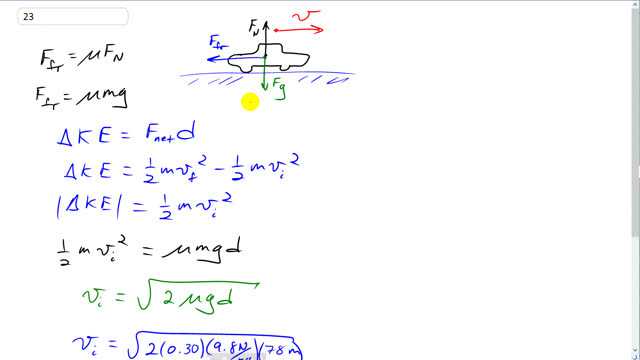
At an accident scene on a level road, investigators measure a car’s skid mark to be 78 m long. It was a rainy day and the coefficient of friction was estimated to be 0.30. Use these data to determine the speed of the car when the driver slammed on (and locked) the brakes. (Why does the car’s mass not matter?)

In order to watch this solution you need to have a subscription.
This is Giancoli Answers with Mr. Dychko. Here's a free-body diagram of a car as it's moving to the right. There's gonna be friction to the left; there's gravity down and there's gonna be a normal force upwards of equal size to the gravity because there's no vertical acceleration. The friction force is µ times F N, the coefficient of friction times the normal force. And so, as we were saying, the normal force is mg and so friction is µ times mg. And friction is the net force because it's the only force that's horizontal; so the change in kinetic energy is gonna be this friction force times displacement. And you could also say, change in kinetic energy is one-half m v final squared, which is 0 because it comes to a stop, minus one-half m v i squared and let's forget about the negative sign there and just say the the change in kinetic energy, magnitude, is one-half m v initial squared. So, this means we can say that since one-half m v initial squared is the change in kinetic energy, we can say it equals F net times d since it also equals the change in kinetic energy. But, F net is µmg so I wrote that here. So this is F net times d. And then we'll solve this for v i. So let's cancel the m's, and that's why mass doesn't matter because it cancels on both sides of this formula and we have, multiply both sides by 2, take the square root of both sides and the initial speed is the square root of 2 times 0.30 times 9.8 newtons per kilogram times 78 meters and that gives 21 meters per second— must have been the initial speed.
Why are you allowed to take the absolute value of KE? Shouldn't it be -1/2mvi^2 instead of positive?
Hi mschick16, thanks for the question. I suppose it was unnecessary to take the absolute value of KE. You can safely ignore that part. It's just the way I was thinking about the problem in terms of magnitudes, rather than bothering with direction. Consider this different approach that I think you'll prefer in which I'm following the negative signs properly:
I think you'll agree that , and the video shows that , so this means . This means is negative, which we expect from the diagram since it's the friction force directed opposite to the direction of the initial velocity. where I'm taking all the forces to the right (of which there are none, hence the zero), minus the forces to the left (just friction). Therefore , and then substituting above gives , and this leads to the final expression in the video for initial velocity. That's a lot of extra trouble to follow the negative signs, which is why I skipped it, but following the negatives is more rigorous, so it's good stuff.
All the best,
Mr. Dychko
Thank you for the negative sign following explanation in writing! It was very helpful!
Glad it was helpful!